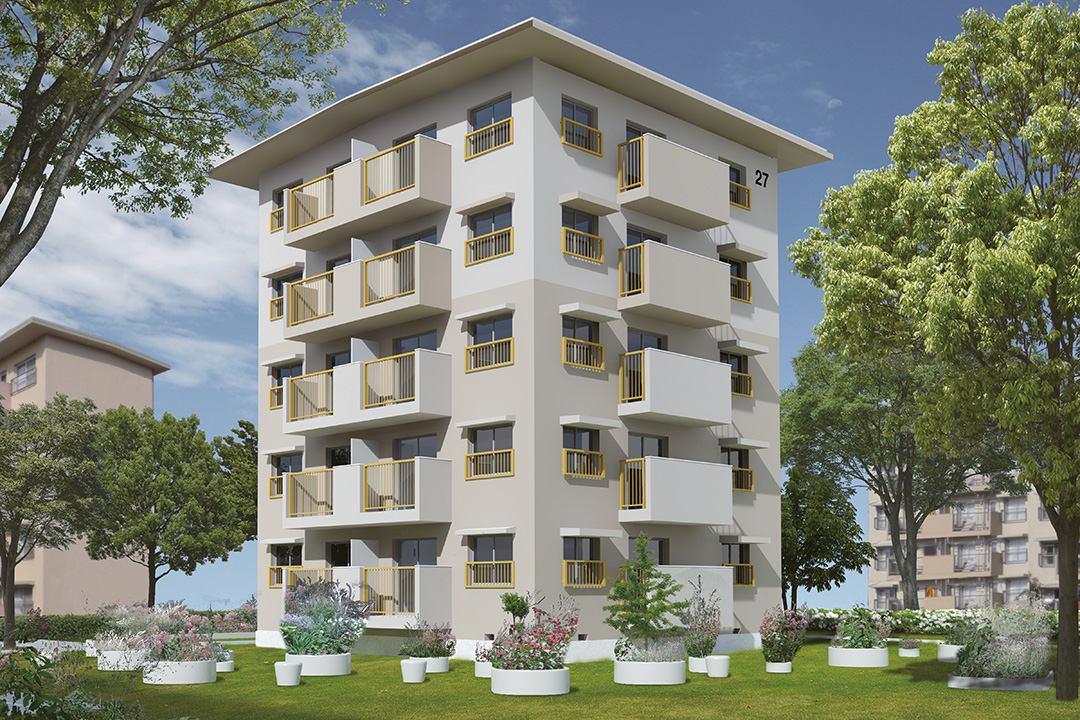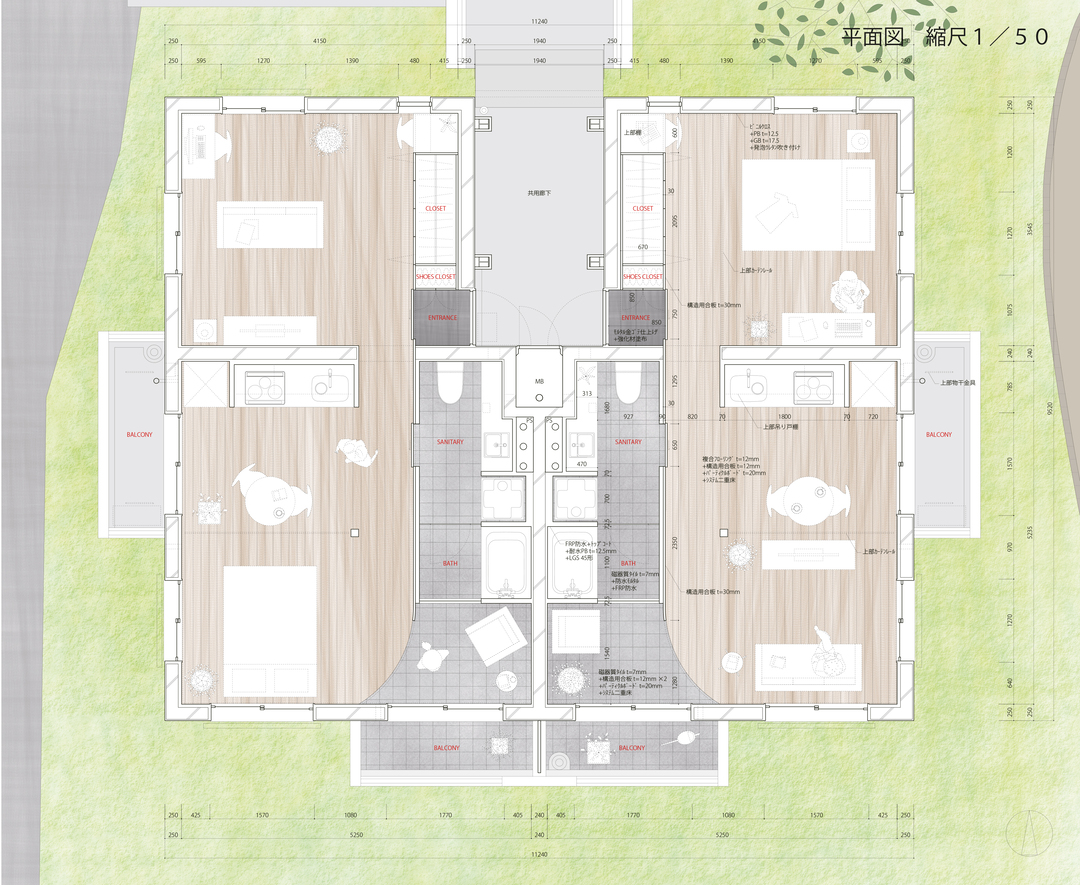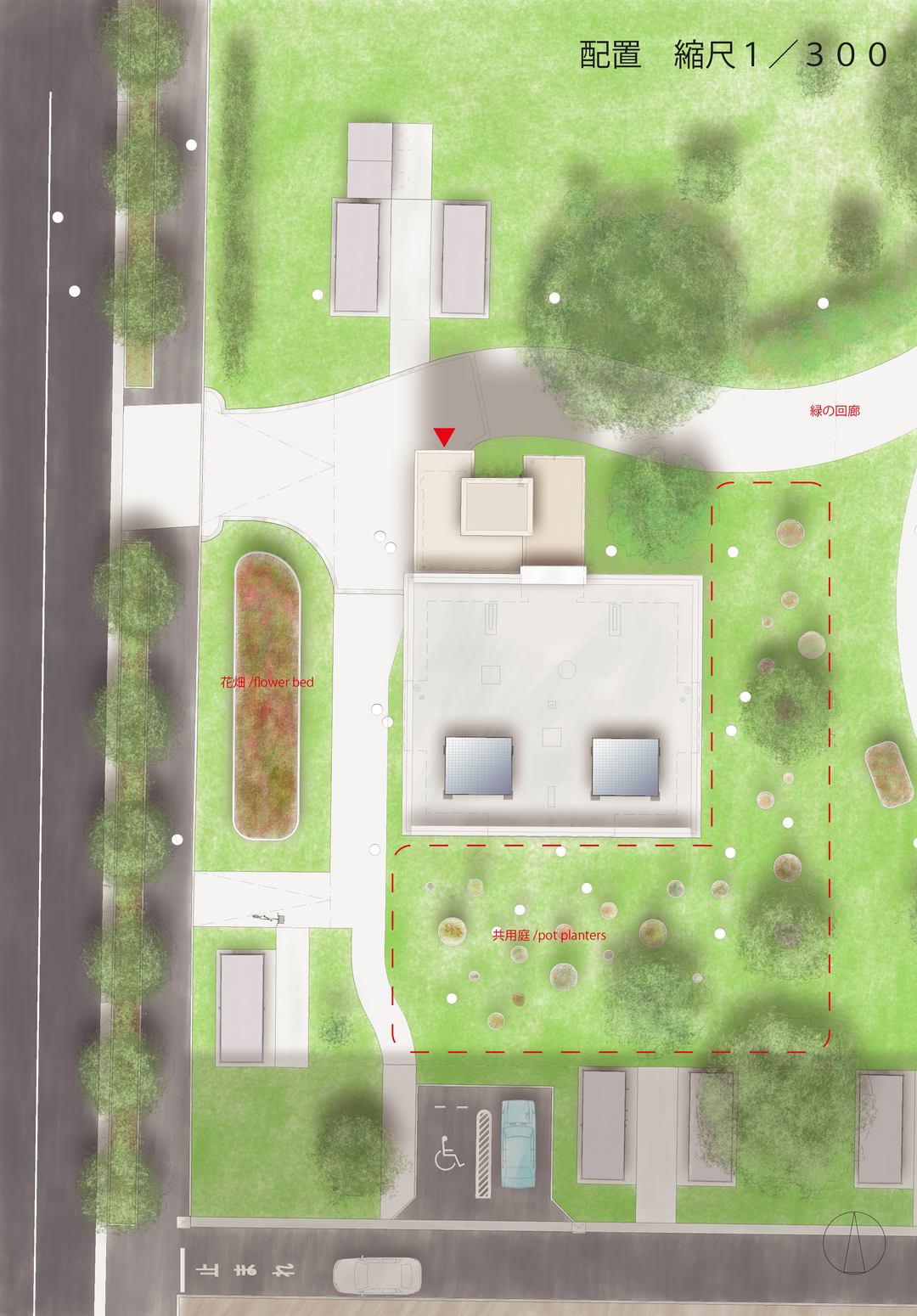
Hanahata housing complex
花畑団地27号棟はEV 棟が取付けられ、高齢者や身障者への配慮がなされている。団地全体の居住者に占める高齢者の割合は約4割と、居住者像は高齢化を視野に入れない訳にはいかない。また、花畑団地の事業概要として商業施設や高齢者・子育て世帯などが利用する拠点施設の誘致などがあり、居住地域の生活環境づくりや少子高齢化の進展、魅力ある生活中心地の形成といった地区計画から、
・子育て夫婦、あるいは結婚生活を始める若い世代の夫婦
→新たなファミリー層を誘導
・高齢者夫婦、あるいは単身高齢者
→既存居住者やアクティブシニアへの住戸提供
これらの異なる年代の住人を居住者として想定し、地域性とさまざまな計画性に応えることのできる提案とする。
賃貸住宅として多様性を受け入れられるプランとするため、フレキシブルな居住スペースを大きくとっている。細かく仕切られていた既存壁を撤去し、住戸内の空間がつながりをもつ空間とした。住戸は全て同じプランニングとし、居住者が家具の配置によって生活を構築することができる。居住スペースを大きくとるため、水廻りは中央にまとめているが、狭くなりがちな脱衣・洗面スペースも広く取ることができ、ミニマルな動線と子育てや介助に伴う作業、動作に対して、配慮した設計としている。
居住スペースと水廻りスペースは一枚の壁で間仕切られ、温もりを感じる合板の仕上げと緩やかに弧を描く曲面が、多様性を受け入れる優しい空間を演出している。


Reactivating the sense of place. Housing for young couples and active seniors
The Subject of this competition is one building within the Hanahata Housing complex constructed in 1965 and owned by UR (Urban Renaissance Agency). For the design of these to be refurbished apartments there is good reason to take the elderly as one of the target groups, because in the whole of this complex, the social built up shows that the percentage of elderly on the total of tenants is about 40% and taken into account the progressing aging of the Japanese population. Also building nr 27 is one of the few buildings in the Hanahata Housing complex that is fitted with an elevator and this makes the building particularly suitable for habitation by the elderly, people with disabilities and young families.
Furthermore, taking into account the complex’s extended business aims, focusing on commercial facilities and hub-centers to be used by groups such as elderly citizens as well as families with small children, the basis for the design of an appealing living environment should take into account the social development of a declining birthrate and a growing proportion of elderly people. Therefore, in response to this, we have taken as base for our proposal to offer housing for the following target groups;
– NEW FAMILIES; young couples with children, or just married couples
– ACTIVE SENIORS; elderly couples, single elderly persons who already live in the complex or from elsewhere, assuming that a mix of different age groups could live in this building.
In the first place our refurbishment proposal responds to and reactivates the buildings sense of place that is determined by the fact that it was built 47 years ago in the style of an apartment complex of its age. The competition brief posed rather severe restrictions on the design intervention that allowed little or no change to the structure of the building, asked for an interior design, a color scheme based on given colors in the regional master plan for the façade and ideas for the use of the green space around the building.
The key to our solution is to provide punctual interventions, which expose hidden qualities of the building and its spaces whilst leaving the building in tact. At planning level we propose along this philosophy, a type of apartment that, through great flexibility in use, can accommodate plural live styles. This is achieved by taking out all separation walls and by placing all auxiliary functions (sanitary, bathroom, washroom, entrance, closet and work table as well as a sunroom) except for the kitchen behind one single wall that travels the length of the apartment and unifies the space. The resulting large cleaned-up-space is left unencumbered and can be freely interpreted by the occupants.
The thus way centralized sanitary spaces, placed in a deep services zone forming a new core to the building, are relatively spacious and therefore easy to use for all target groups. This quality and the efficiently designed minimal walk lines, allow occupants and in particular elderly and or handicapped occupants to go about their lives unassisted.
Leaving in tact the typology of the apartment building with two apartments per floor, the strategic placement of the core along the separation wall in the middle of the block, results in a strengthening of one of the greatest qualities of the apartment block; this is that all apartments are North-South oriented and are always corner apartments. This arrangement guarantees free views to the North and South and/or to the North-West or North-East.
In general in apartment buildings the bathroom and sanitary space is placed internally and is mechanically ventilated. Our proposal allows the sanitary space to receive an abundance of natural light through a large window facing the South balcony and its sunroom as well as for natural ventilation of these spaces.
In principle all apartments are designed along this basic concept, but as the occupants have different living patterns and needs they will naturally place their furniture along their own visions of the space resulting in a lot of variation. They can place their furniture freely or add soft partitioning by using the pre-installed curtain rails to fit their needs.
The wall, designed in wood, ads warmth to the space and it’s arcing away before touching the exterior wall forms a sunroom connecting to the South facing balcony. This unusual space finished with the same material as the balcony brings the exterior into the apartment and can just as well become an internal green space, something so much lacking in these housing complexes.
The shapes of openings in the wall are a reference to the age in which the building was conceived; the years 60 with its trackers mentality. The rounded corners are a subtle reference to the shape of doors of campers and the aesthetics of the time.
The urban design of the time created large communal open green spaces along the CIAM ideas, believing that this would create healthy living environments. And this is very much a characteristic of the age, which had very much a penchant for placing objects in space rather than creating enclosed space. Therefore also in this complex the relation to the green space is one of objects floating in it. The direct functional connection is rather thin. For example the first floor apartments do not have any exterior space on ground floor level other that a standard balcony floating just above the ground. No direct connection or access is made with the green space. This means that the exterior is just on view.
To improve this situation we propose to add lots of randomly placed round planters and seats in the field around the building, in tune with the idea of objects placed in space. This intervention gives extra meaning to and reactivates this undetermined space around the building, by allowing residents to use these oversized pots as their little gardens for flowers, plants or even vegetables. They gather around them and develop activities in the area and through these activities create a sense of community.
The planters to the West and East of the building will be planted with wild flowers and plants that require little maintenance but are beautiful because they show the changes of the seasons; a view that can be enjoyed year round from each apartment.






所在地:東京都
主要用途:集合住宅
敷地面積:180㎡
建築面積:146,118㎡
延床面積:146,118㎡
設計
建築:フランク・ラ・リヴィエレ アーキテクツ
>フランク・ラ・リヴィエレ
>嘉成 龍
>有汲 幸亮
>キム・テヨン
Location:Tokyo, japan
Principal use:apartment house
Site area:180m2
Building area:146,118m2
Total floor area:146,118m2
DesignArchitecture:
Frank la Rivière Architects
>Frank la Rivière
>Ryu Kanari
>Kousuke Arikumi
>Taeyoung Kim
Kanagawa 2012.08